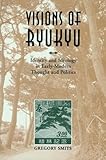Visions of Ryukyu : Identity and Ideology in Early-Modern Thought and Politics / Gregory Smits.
Material type: TextPublisher: Honolulu : University of Hawaii Press, [1999]Copyright date: ©1999Description: 1 online resource (224 p.)Content type:
TextPublisher: Honolulu : University of Hawaii Press, [1999]Copyright date: ©1999Description: 1 online resource (224 p.)Content type: - 9780824865498
- 952/.29
- DS895.R95 S65 1999
- online - DeGruyter
| Item type | Current library | Call number | URL | Status | Notes | Barcode | |
|---|---|---|---|---|---|---|---|
 eBook
eBook
|
Biblioteca "Angelicum" Pont. Univ. S.Tommaso d'Aquino Nuvola online | online - DeGruyter (Browse shelf(Opens below)) | Online access | Not for loan (Accesso limitato) | Accesso per gli utenti autorizzati / Access for authorized users | (dgr)9780824865498 |
Browsing Biblioteca "Angelicum" Pont. Univ. S.Tommaso d'Aquino shelves, Shelving location: Nuvola online Close shelf browser (Hides shelf browser)

|

|

|

|

|

|

|
||
| online - DeGruyter Violence and Colonial Dialogue : The Australian-Pacific Indentured Labor Trade / | online - DeGruyter Violence and Serenity : Late Buddhist Sculpture from Indonesia / | online - DeGruyter Virgin Widows / | online - DeGruyter Visions of Ryukyu : Identity and Ideology in Early-Modern Thought and Politics / | online - DeGruyter Voices from the Straw Mat : Toward an Ethnography of Korean Story Singing / | online - DeGruyter Voyages and Beaches : Pacific Encounters, 1769-1840 / | online - DeGruyter Waikiki : A History of Forgetting and Remembering / |
Frontmatter -- Contents -- Acknowledgments -- Introduction -- Chapter 1. The Status of Ryukyu and Its Relations with Japan and China -- Chapter 2. Looking North and Looking West: Shō Shōken and Tei Junsoku -- Chapter 3. Empowering Ryukyuans: The Theoretical Foundations of Sai On’s Ryuku -- Chapter 4. Re-Creating Ryukyu: Sai On and His Critics -- Chapter 5. Contested Visions of Sai On’s Ryukyu -- Epilogue and Conclusions -- Appendix 1: Ryukyuan Kings -- Appendix 2: Glossary of Selected Ryukyuan Terms -- List of Abbreviations -- Notes -- Works Cited -- Index
restricted access online access with authorization star
http://purl.org/coar/access_right/c_16ec
Between 1609 and 1879, the geographical, political, and ideological status of the Kingdom of Ryukyu (modern Okinawa) was characterized by its ambiguity. It was subordinate to its larger neighbors, China and Japan, yet an integral part of neither. A Japanese invasion force from Satsuma had conquered the kingdom in 1609, resulting in its partial incorporation into Tokugawa Japan's bakuhan state. Given Ryukyu's long-standing ties with China and East Asian foreign relations following the rise of the Qing dynasty, however, the bakufu maintained only an indirect link with Ryukyu from the mid-seventeenth century onward. Thus Ryukyu was able to exist as a quasi-independent kingdom for more than two centuries-albeit amidst a complex web of trade and diplomatic agreements involving the bakufu, Satsuma, Fujian, and Beijing. During this time, Ryukyu's ambiguous position relative to China and Japan prompted its elites to fashion their own visions of Ryukyuan identity. Created in a dialogic relationship to both a Chinese and Japanese Other, these visions informed political programs intended to remake Ryukyu.In this innovative and provocative study, Gregory Smits explores early-modern perceptions of Ryukyu and their effect on its political culture and institutions. He describes the major historical circumstances that informed early-modern discourses of Ryukyuan identity and examines the strategies used by leading intellectual and political figures to fashion, promote, and implement their visions of Ryukyu. Early-modern visions of Ryukyu were based on Confucianism, Buddhism, and other ideologies of the time. Eventually one vision prevailed, becoming the theoretical basis of the early-modern state by the middle of the eighteenth century. Employing elements of Confucianism, the scholar and government official Sai On (1682-1761) argued that the kingdom's destiny lay primarily with Ryukyuans themselves and that moral parity with Japan and China was within its grasp. Despite Satsuma's control over its diplomatic and economic affairs, Sai envisioned Ryukyu as an ideal Confucian state with government and state rituals based on the Chinese model. In examining Sai's thought and political program, this volume sheds new light on Confucian praxis and, conversely, uncovers one variety of an East Asian "prenational" imagined political/cultural community.
Mode of access: Internet via World Wide Web.
In English.
Description based on online resource; title from PDF title page (publisher's Web site, viewed 02. Mrz 2022)


